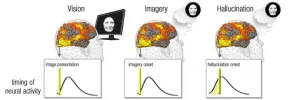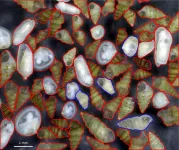Proteogenomics offers insight to treating head and neck squamous cell carcinoma
2021-01-07
(Press-News.org) HOUSTON - (Jan. 7, 2021) - Proteogenomic analysis may offer new insight into matching cancer patients with an effective therapy for their particular cancer. A new study identifies three molecular subtypes in head and neck squamous cell carcinoma (HNSCC) that could be used to better determine appropriate treatment. The research led by Baylor College of Medicine, Johns Hopkins University and the National Cancer Institute's Clinical Proteomic Tumor Analysis Consortium (CPTAC) is published in the journal Cancer Cell.
Researchers profiled proteins, phosphosites and signaling pathways in 108 human papillomavirus-negative HNSCC tumors in order to understand how genetic aberrations drive tumor behavior and response to therapies. Currently, there are a few FDA-approved therapies for HNSCC, including an epidermal growth factor receptor (EGFR) monoclonal antibody (mAb) inhibitor and two PD-1 inhibitors, but response rates are moderate. In this study, researchers aimed to find out why certain patients respond to certain treatments to better match the patient to an appropriate course of treatment.
"We found three subtypes of head and neck squamous cell carcinoma, and each subtype may be good candidates for a different type of therapy - EGFR inhibitors, CDK inhibitors or immunotherapy," said Dr. Bing Zhang, lead contact of the study and professor in the Lester and Sue Smith Breast Center and the Department of Molecular and Human Genetics at Baylor. "We also identified candidate biomarkers that could be used to match patients to effective therapies or clinical trials."
Finding effective biomarkers
One important finding involved matching HNSCC patients to EGFR mAb inhibitors. Cetuximab, an EGFR mAb medication, was approved by the FDA in 2006 as the first targeted therapy for HNSCC, however the success rate for this treatment is low. Moreover, EGFR amplification or overexpression cannot predict response to EGFR mAbs. In this study, researchers found that EGFR ligands, instead of EGFR itself, act as the limiting factor for EGFR pathway activation. When ligand is low, the downstream pathway will not be triggered, even if EGFR protein is highly overexpressed.
"We proposed that the EGFR ligand should be used as a biomarker, rather than EGFR amplification or overexpression, to help select patients for the EGFR monoclonal antibody treatment," said Zhang, a member of the Dan L Duncan Comprehensive Cancer Center, a Cancer Prevention & Research Institute of Texas (CPRIT) Scholar and a McNair Scholar at Baylor. "Tumors with high EGFR amplification do not necessarily have high levels of EGFR ligands, which may underlie their lack of response to EGFR mAb therapy." The team confirmed this hypothesis by analyzing previously published data from patient-derived xenograft models and a clinical trial.
Additionally, tracking a key tumor suppressor known as Rb (retinoblastoma), the research team identified a striking finding that suggests that Rb phosphorylation status could potentially be a better indicator of a patient's response to CDK4/6 inhibitor therapy. The study showed that the many mutations in the genes regulating CDK4/6 activity were neither necessary nor sufficient for activation of CDK4/6. The team found that the CDK4 activity was best measured through Rb phosphorylation measurements, thus identifying a potential measure for patient selection in CDK inhibitor clinical trials.
Immunotherapy insights
The research team also found important insights into the effectiveness of immunotherapy. PD-1 inhibitors target the interaction between immune checkpoints PD-1 and PD-L1, but success rates of immunotherapy are low, even when PD-L1 expression is used for patient selection. The researchers examined tumors with high expression of PD-L1 and found that when a tumor overexpresses PD-L1, it also upregulates other immune checkpoints, thus allowing the tumor growth despite the use of PD-1 inhibitors. This observation suggests that PD-1 and PD-L1 activated tumors with hot immune environments may require multiple types of immunotherapy, which target different immune checkpoint proteins, to be effective.
Conversely, tumors with cold immune environments are not good targets for immunotherapy. Examination of how a tumor becomes immune-cold tumor showed that the problem stems from a flaw in its antigen presentation pathway where multiple key gene components of the antigen presentation pathway were deleted. As a result, although tumor antigens are being expressed, the immune system is not able to recognize them on the surface of the cell and therefore fail to activate the body's defense system against the tumor. These deletions have the potential to be effective targets for future therapies.
"This study extends our biological understanding of HPV-negative HNSCCs and generates therapeutic hypotheses that may serve as the basis for future studies and clinical trials toward molecularly-guided precision medicine treatment of this aggressive cancer type," said Dr. Daniel W. Chan, co-corresponding author of the study, professor of pathology and oncology, and director of the Center for Biomarker Discovery and Translation at the Johns Hopkins University School of Medicine.
INFORMATION:
For a full list of contributing authors, see the publication. This work was supported by grants U24 CA210954, U24 CA210985, U24 CA210972, U24 CA210979, U24 CA210986, U24 CA214125, U24 CA210967, and U24 CA210993 from the National Cancer Institute (NCI) Clinical Proteomic Tumor Analysis Consortium (CPTAC), by a Cancer Prevention Institute of Texas (CPRIT) award RR160027, by grant T32 CA203690 from the Translational Breast Cancer Research Training Program, and by funding from the McNair Medical Institute at the Robert and Janice McNair Foundation.
ELSE PRESS RELEASES FROM THIS DATE:
2021-01-07
TROY, N.Y. -- In a money-saving revelation for organizations inclined to invest in specialized information technology to support the process of idea generation, new research suggests that even non-specialized, everyday organizational IT can encourage employees' creativity.
Recently published in the journal Information and Organization, these findings from Dorit Nevo, an associate professor in the Lally School of Management at Rensselaer Polytechnic Institute, show standard IT can be used for innovation. Furthermore, this is much more likely to happen when the technology is in the hands of employees who are motivated to master technology, understand their role in the organization, ...
2021-01-07
In a study to examine a Mediterranean diet in relation to prostate cancer progression in men on active surveillance, researchers from The University of Texas MD Anderson Cancer Center found that men with localized prostate cancer who reported a baseline dietary pattern that more closely follows the key principles of a Mediterranean-style diet fared better over the course of their disease.
"Men with prostate cancer are motivated to find a way to impact the advancement of their disease and improve their quality of life," said Justin Gregg, M.D., assistant professor of Urology and lead author of the study, published today in Cancer. ...
2021-01-07
Tsukuba, Japan - Does losing weight while you sleep sound too good to be true? According to a study by the University of Tsukuba, it seems that drinking oolong tea might help you do just that.
While all tea comes from the same plant, Camellia sinensis, the degree of oxidation, a chemical reaction that turns tea leaves black, defines its specific type. For example, green tea is unoxidized and mild in flavor, while the distinctive color of black tea comes from complete oxidation. Oolong tea, being only partially oxidized, lies somewhere in between and displays characteristics ...
2021-01-07
Some people have lost their eyesight, but they continue to "see." This phenomenon, a kind of vivid visual hallucination, is named after the Swiss doctor, Charles Bonnet, who described in 1769 how his completely blind grandfather experienced vivid, detailed visions of people, animals and objects. Charles Bonnet syndrome, which appears in those who have lost their eyesight, was investigated in a study led by scientists at the Weizmann Institute of Science. The findings, published today in Brain, suggest a mechanism by which normal, spontaneous activity in the visual centers of the brain can trigger visual hallucinations in the blind.
Prof. Rafi Malach and his group members of the Institute's Neurobiology Department research the phenomenon of spontaneous "resting-state" ...
2021-01-07
Research from life-saving charity Air Ambulance Kent Surrey Sussex (KSS) in partnership with the University of Surrey has shown the benefits of dispatching HEMS to patients with a sudden, unexplained LOC of medical origin and a high prevalence of acute neurological pathology.
The study - which is believed to be the first published about HEMS dispatch to non-trauma (neuro) cases - also highlights how HEMS dispatchers in dialogue with ambulance personnel are able to select patients requiring HEMS-specific interventions and, based on its findings, identifies opportunities to improve triage for these patients.
Through a retrospective study of all patients with a LOC ...
2021-01-07
In a study spanning four decades, researchers from the University of Hong Kong's Research Division for Ecology & Biodiversity (HKU) in the Faculty of Science, and Toho University's Department of Biology (Toho), Japan, have discovered that predation by snakes is pushing lizards to be active at warmer body temperatures on islands where snakes are present, in comparison to islands free from snakes. Their work also detected significant climatic warming throughout the years and found lizard body temperatures to have also increased accordingly. The findings show that lizard thermal biology is highly dependent on predation pressures ...
2021-01-07
Geneva, Switzerland, 7 January 2021 - 'Mini-brains' are pin-head sized collections of several different types of human brain cell. They are used as a tool, allowing scientists to learn about how the brain develops, study disease and test new medicines. Personalized 'mini-brains' can be grown from stem cells generated from a sample of human hair or skin and could shed light on how brain disease progresses in an individual and how this person may respond to drugs.
Research published today by a team of scientists and engineers from HEPIA and the Wyss Center for Bio and Neuroengineering, in the journal Frontiers in Bioengineering and Biotechnology, has revealed ...
2021-01-07
Until now, the reason why the drug levodopa (L-Dopa), which reduces the motor symptoms of Parkinson's disease, declines in efficacy after a few years' use has been unknown. A side effect that then often occur is involuntary movements. A Swedish-French collaboration, led from Uppsala University, has now been able to connect the problems with defective metabolism of L-Dopa in the brain. The study is published in Science Advances.
"The findings may lead to new strategies for treating advanced Parkinson's," says Professor Per Andrén of the Department of Pharmaceutical Biosciences at Uppsala University. He and Dr Erwan Bézard of the University of Bordeaux, France, headed ...
2021-01-07
The coastline of Israel is one of the warmest areas in the Mediterranean Sea. Here, most marine species have been at the limits of their tolerance to high temperatures for a long time - and now they are already beyond those limits. Global warming has led to an increase in sea temperatures beyond those temperatures that Mediterranean species can sustain. Consequently, many of them are going locally extinct.
Paolo Albano's team quantified this local extinction for marine molluscs, an invertebrate group encompassing snails, clams and mussels. They thoroughly surveyed the Israeli coastline and ...
2021-01-07
Sweden kept preschools, primary and lower secondary schools open during the spring of 2020. So far, little research has been done on the risk of children being seriously affected by COVID-19 when the schools were open. A study from Karolinska Institutet in Sweden has now shown that one child in 130,000 was treated in an intensive care unit on account of COVID-19 during March-June. The study has been published in New England Journal of Medicine.
So far, more than 80 million people have become ill with COVID-19 and globally, almost two million people have died from the disease. Many countries have closed down parts of society in order to reduce the spread of infection. One such measure has been to close schools. ...
LAST 30 PRESS RELEASES:
[Press-News.org] Proteogenomics offers insight to treating head and neck squamous cell carcinoma



